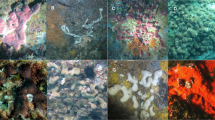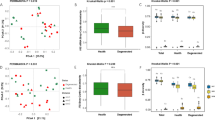Abstract
Changes in agricultural land-use of saltmarshes along the German North Sea coast have favoured the succession of the marsh grass Elytrigia atherica over the long-established Spartina anglica. Consequently, E. atherica represents a potential food source of increasing importance for plant-feeding soil detritivores. Considering the importance of this ecological guild for decomposition processes and nutrient cycling, we focussed on two sympatric saltmarsh soil macrodetritivores and their associated gut microbiota to investigate how the digestive processes of these species may be affected by changing plant food sources. Using genetic fingerprints of partial 16S rRNA gene sequences, we analysed composition and diversity of the bacterial gut community in a diplopod and an amphipod crustacean in relation to different feeding regimes representing the natural vegetation changes. Effects of syntopy on the host-specific gut microbiota were also taken into account by feeding the two detritivore species either independently or on the same plant sample. Bacterial community composition was influenced by both the host species and the available plant food sources, but the latter had a stronger effect on microbial community structure. Furthermore, bacterial diversity was highest after feeding on a mixture of both plant species, regardless of the host species. The gut microbiota of these two detritivores can thus be expected to change along with the on-going succession at the plant community level in this environment. Cloning and sequencing of bacterial 16S rRNA gene fragments further indicated a host-related effect since the two detritivores differed in terms of predominant bacterial taxa: diplopods harboured mainly representatives of the phyla Bacteroidetes and Gammaproteobacteria. In contrast, the genus Vibrio was found for the amphipod host across all feeding conditions.




Similar content being viewed by others
References
Andresen H, Bakker JP, Brongers M, Heydemann B, Irmler U (1990) Long-term changes of salt marsh communities by cattle grazing. Vegetatio 89:137–148
Gettner S (2002) Vegetationsveränderungen in Festland-Salzmarschen an der Westküste Schleswig-Holsteins-elf Jahre nach Änderung der Nutzungen. Kiel Not Pflanzenkd Schleswig-Holstein Hamb 31:69–83
Bos D, Bakker JP, de Vries Y, van Lieshout S (2002) Long-term vegetation changes in experimentally grazed and ungrazed back barrier marshes in the Wadden Sea. Appl Veg Sci 5:45–54
Kiehl K, Eischeid I, Gettner S, Walter J (1996) Impact of different sheep grazing intensities on salt marsh vegetation in northern Germany. J Veget Sci 7:99–106
Esselink P, Zijlstra W, Dijkema KS, van Diggelen R (2000) The effects of decreased management on plant-species distribution patterns in a salt marsh nature reserve in the Wadden Sea. Biol Cons 93:61–76
Graça MA, Newell SY, Kneib RT (2000) Grazing rates of organic matter and living fungal biomass of decaying Spartina alterniflora by three species of salt-marsh invertebrates. Mar Biol 136:281–289
Zimmer M, Pennings SC, Buck TL, Carefoot TH (2002) Species-specific patterns of litter processing by terrestrial isopods (Isopoda: Oniscidea) in high intertidal salt marshes and coastal forests. Funct Ecol 16:596–607
Zimmer M, Pennings SC, Buck TL, Carefoot TH (2004) Salt marsh litter and detritivores: a closer look at redundancy. Estuaries 27:753–769
Morritt D, Spicer JI (1998) Physiological ecology of talitrid amphipods: an update. Can J Zool 76:1965–1982
Morritt D, Ingolfsson A (2000) Upper thermal tolerances of the beachflea Orchestia gammarellus (Pallas) (Crustacea: Amphipoda: Talitridae) associated with hot springs in Iceland. J Exp Mar Bio Ecol 255:215–227
Morritt D, Spicer JI (1996) Developmental ecophysiology of the beach flea Orchestia gammarellus (Pallas) (Crustacea: Amphipoda) II. Embryonic osmoregulation. J Exp Mar Bio Ecol 207:205–216
Morritt D, Spicer JI (1999) Developmental ecophysiology of the beach flea Orchestia gammarellus (Pallas) (Crustacea: Amphipoda: Talitridea) III. Physiological competency as a possible explanation for timing of hatchling release. J Exp Mar Bio Ecol 232:275–283
Barber AD (2009) Littoral myriapods: a review. Soil Organisms 81:735–760
Veen GF, Geuverink E, Olff H (2012) Large grazers modify effects of aboveground–belowground interactions on small-scale plant community composition. Oecologia 168:511–518
Buth GJC, de Wolf L (1985) Decomposition of Spartina anglica, Elytrigia pungens and Halimione portulacoides in a Dutch salt marsh in association with faunal and habitat influences. Vegetatio 62:337–355
King AJ, Cragg SM, Li Y, Dymond J, Guille MJ, Bowles DJ, Bruce NC, Graham IA, McQueen-Mason SJ (2010) Molecular insight into lignocellulose digestion by a marine isopod in the absence of gut microbes. Proc Natl Acad Sci U S A 107:5345–5350
Wood TM (1985) Properties of cellulolytic enzyme systems. Biochem Soc Trans 13:407–410
Wong DW (2009) Structure and action mechanism of ligninolytic enzymes. Appl Biochem Biotechnol 157:174–209
Behar A, Yuval B, Jurkevitch E (2005) Enterobacteria-mediated nitrogen fixation in natural populations of the fruit fly Ceratitis capitata. Mol Ecol 14:2637–2643
Zimmer M, Danko JP, Pennings SC, Danford AR, Ziegler A, Uglow RF, Carefoot TH (2001) Hepatopancreatic endosymbionts in coastal isopods (Crustacea: Isopoda), and their contribution to digestion. Mar Biol 138:955–963
Zimmer M, Danko JP, Pennings SC, Danford AR, Carefoot TH, Ziegler A, Uglow RF (2002) Cellulose digestion and phenol oxidation in coastal isopods (Crustacea: Isopoda). Mar Biol 140:1207–1213
Zimmer M, Bartholmé S (2003) Bacterial endosymbionts in Asellus aquaticus (Isopoda) and Gammarus pulex (Amphipoda) and their contribution to digestion. Limnol Oceanogr 48:2208–2213
Kaufman MG, Klug MJ (1991) The contribution of hindgut bacteria to dietary carbohydrate utilization by crickets (Orthoptera: Gryllidae). Comp Biochem Physiol A 98:117–123
Warnecke F, Luginbuhl P, Ivanova N, Ghassemian M, Richardson TH, Stege JT, Cayouette M, McHardy AC, Djordjevic G, Aboushadi N, Sorek R, Tringe SG, Podar M, Martin HG, Kunin V, Dalevi D, Madejska J, Kirton E, Platt D, Szeto E, Salamov A, Barry K, Mikhailova N, Kyrpides NC, Matson EG, Ottesen EA, Zhang X, Hernandez M, Murillo C, Acosta LG, Rigoutsos I, Tamayo G, Green BD, Chang C, Rubin EM, Mathur EJ, Robertson DE, Hugenholtz P, Leadbetter JR (2007) Metagenomic and functional analysis of hindgut microbiota of a wood-feeding higher termite. Nature 450:560–565
Santo Domingo JW, Kaufman MG, Klug MJ, Holben WE, Harris D, Tiedje JM (1998) Influence of diet on the structure and function of the bacterial hindgut community of crickets. Mol Ecol 7:761–767
Knapp BA, Podmirseg SM, Seeber J, Meyer E, Insam H (2009) Diet-related composition of the gut microbiota of Lumbricus rubellus as revealed by a molecular fingerprinting technique and cloning. Soil Biol Biochem 41:2299–2307
Knapp BA, Seeber J, Podmirseg SM, Rief A, Meyer E, Insam H (2009) Molecular fingerprinting analysis of the gut microbiota of Cylindroiulus fulviceps (Diplopoda). Pedobiologia 52:325–336
Kocher TD, Thomas WK, Meyer A, Edwards SV, Paabo S, Villablanca FX, Wilson AC (1989) Dynamics of mitochondrial DNA evolution in animals: amplification and sequencing with conserved primers. Proc Natl Acad Sci U S A 86:6196–6200
Muyzer G, de Waal EC, Uitterlinden AG (1993) Profiling of complex microbial populations by denaturing gradient gel electrophoresis analysis of polymerase chain reaction-amplified genes coding for 16S rRNA. Appl Environ Microbiol 59:695–700
Zouache K, Voronin D, Tran-Van V, Mavingui P (2009) Composition of bacterial communities associated with natural and laboratory populations of Asobara tabida infected with Wolbachia. Appl Environ Microbiol 75:3755–3764
Weisburg WG, Barns SM, Pelletier DA, Lane DJ (1991) 16S ribosomal DNA amplification for phylogenetic study. J Bacteriol 173:697–703
Rousset F, Vautrin D, Solignac M (1992) Molecular identification of Wolbachia, the agent of cytoplasmic incompatibility in Drosophila simulans, and variability in relation with host mitochondrial types. Proc Biol Sci 247:163–168
Culhane AC, Perriere G, Considine EC, Cotter TG, Higgins DG (2002) Between-group analysis of microarray data. Bioinformatics 18:1600–1608
Shannon CE (1948) A mathematical theory of communication. Bell Syst Tech J 27:379–423
Huson DH, Auch AF, Qi J, Schuster SC (2007) MEGAN analysis of metagenomic data. Genome Res 17:377–386
Hongoh Y (2010) Diversity and genomes of uncultured microbial symbionts in the termite gut. Biosci Biotechnol Biochem 74:1145–1151
Brune A (2006) Symbiotic associations between termites and prokaryotes. Prokaryotes 1:439–474
Thompson FL, Iida T, Swings J (2004) Biodiversity of vibrios. Microbiol Mol Biol Rev 68:403–431
Harris JM (1993) The presence, nature, and role of gut microflora in aquatic invertebrates: a synthesis. Microb Ecol 25:195–231
Harris JM, Seiderer LJ, Lucas MI (1991) Gut microflora of two saltmarsh detritivore thalassinid prawns, Upogebia africana and Callianassa kraussi. Microb Ecol 21:277–296
Gomez-Gil B, Tron-Mayén L, Roque A, Turnbull JF, Inglis V, Guerra-Flores AL (1998) Species of Vibrio isolated from hepatopancreas, haemolymph and digestive tract of a population of healthy juvenile Penaeus vannamei. Aquaculture 163:1–9
Dillon RJ, Webster G, Weightman AJ, Dillon VM, Blanford S, Charnley AK (2008) Composition of Acridid gut bacterial communities as revealed by 16S rRNA gene analysis. J Invertebr Pathol 97:265–272
König H (2006) Bacillus species in the intestine of termites and other soil invertebrates. J Appl Microbiol 101:620–627
Lapanje A, Zrimec A, Drobne D, Rupnik M (2010) Long-term Hg pollution-induced structural shifts of bacterial community in the terrestrial isopod (Porcellio scaber) gut. Environ Pollut 158:3186–3193
Acknowledgements
The authors would like to thank Philipp Eereveld for providing the animal samples used in this work as well as the technical staff at the Laboratoire Écologie, Évolution, Symbiose (LEES) for their assistance and Gaël Freyssinel for his advice concerning biodiversity analyses in R.
Author information
Authors and Affiliations
Corresponding author
Rights and permissions
About this article
Cite this article
Dittmer, J., Lesobre, J., Raimond, R. et al. Influence of Changing Plant Food Sources on the Gut Microbiota of Saltmarsh Detritivores. Microb Ecol 64, 814–825 (2012). https://doi.org/10.1007/s00248-012-0056-4
Received:
Accepted:
Published:
Issue Date:
DOI: https://doi.org/10.1007/s00248-012-0056-4




